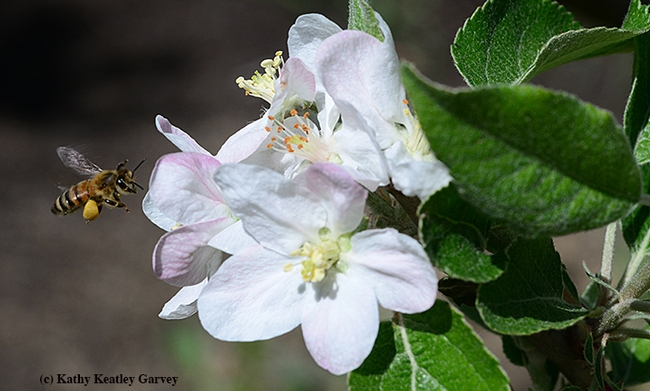- Author: Kathy Keatley Garvey
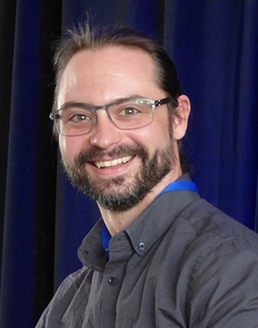
That's what doctoral candidate and ant specialist Brendon Boudinot of the Phil Ward lab, UC Davis Department of Entomology and Nematology, will do when he presents his exit seminar, "Abdomens and Ants: Evolutionary and Phylogenetic Morphology of the Insects" from 4:10 to 5 p.m., Wednesday, March 4 in 122 Briggs Hall on Kleiber Hall Drive, UC Davis campus.
Boudinot, who won the 2019 John Henry Comstock Award, the highest graduate student award given by the Pacific Branch, Entomological Society of America (PBESA), joined the UC Davis entomology graduate school program in 2014.
Abstract of his talk: "It is widely yet loosely agreed that the study of morphology--body form, structure and function--is undergoing a post-genomic revival, cautiously labeled 'phenomics' among active practitioners. I argue that the full reality of phenomics has yet to be realized, and that functional anatomy is the linchpin for the meaningful use of morphological data to understand evolution."
"In this seminar, I will present two case studies from my dissertation. The first will focus on reproductive anatomy in the context of the major transitions of insects from a marine, crustacean ancestor to the epically abundant diversity of wing-bearing species. The second and ongoing study combines more than 300,000 point-observations of morphology for 431 extinct and extant species with genomic sequence data to reconstruct the sequence of evolution leading to the living ants. I will introduce the audience to several extinct lineages of ants, including a new family of wasp-ant intermediates, and present functional morphological reconstructions of the ancestors of all ants, living and extinct."
In nominating Boudinot for the Comstock award, Steve Nadler, professor and chair of the UC Davis Department of Entomology, wrote: “A highly respected scientist, teacher and leader with a keen intellect, unbridled enthusiasm, and an incredible penchant for public service, Brendon maintains a 4.00 grade point average; has published 12 outstanding publications on insect systematics (some are landmarks or ground-breaking publications); and engages in exceptional academic, student and professional activities."
Active in PBESA and the Entomological Society of America (ESA), Boudinot received multiple “President's Prize” awards for his research presentations at national ESA meetings. He organized the ESA symposium, “Evolutionary and Phylogenetic Morphology,” at the 2018 meeting in Vancouver, B.C. , and delivered a presentation on “Male Ants: Past, Present and Prospects” at the 2016 International Congress of Entomology meeting in Orlando, Fla.
Boudinot served on—and anchored—three of the UC Davis Linnaean Games teams that won national or international ESA championships. The Linnaean Games are a lively question-and-answer, college bowl-style competition on entomological facts played between university-sponsored student teams. He has served as president of the UC Davis Entomology Graduate Student Association since 2006, and is active in the campuswide UC Davis Picnic Day; he has co-chaired the department's Picnic Day Committee since 2017.
Boudinot will be among the speakers at an innovative UC Davis symposium on Saving a Bug's Life: Legal Solutions to Combat Insect Biodiversity Decline and the Sixth Mass Extinction, set from 8:30 a.m. to 6:30 p.m., Friday, March 6 in Room 1001 of the School of Law, Mrak Hall. The event, sponsored by UC Davis Environmental Law Society (ELS), will bring together law and science to address insect biodiversity decline. It is free and open to the public. See official program. (RSVP here or on this Facebook page.)
At the March 6 symposium, Boudinot will be part of a three-member panel from 9:50 to 10:55 a.m. on "The Science of Biodiversity Decline." He will be joined by Angela Laws, endangered species conservation biologist, Xerces Society for Invertebrate Conservation; butterfly specialist Arthur Shapiro, distinguished professor, UC Davis Department of Evolution and Ecology; and Lynn Kimsey, UC Davis professor of entomology, director of the Bohart Museum of Entomology and director of the Center for Biosystematics.
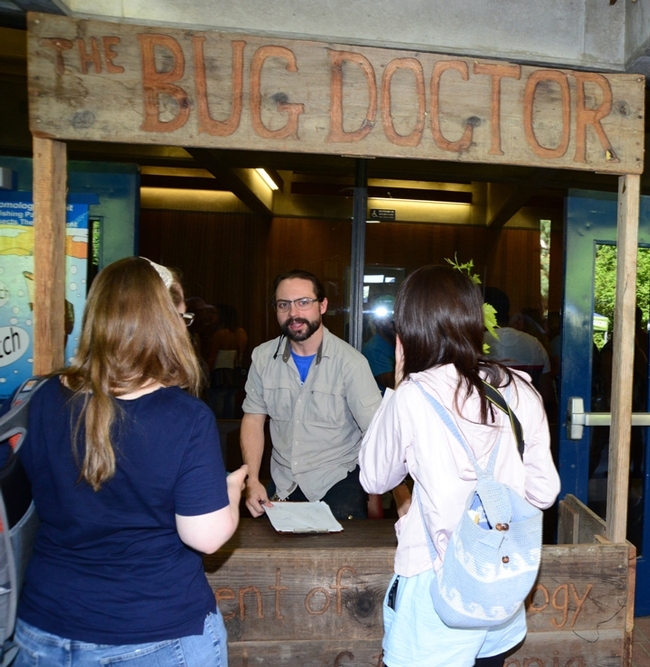
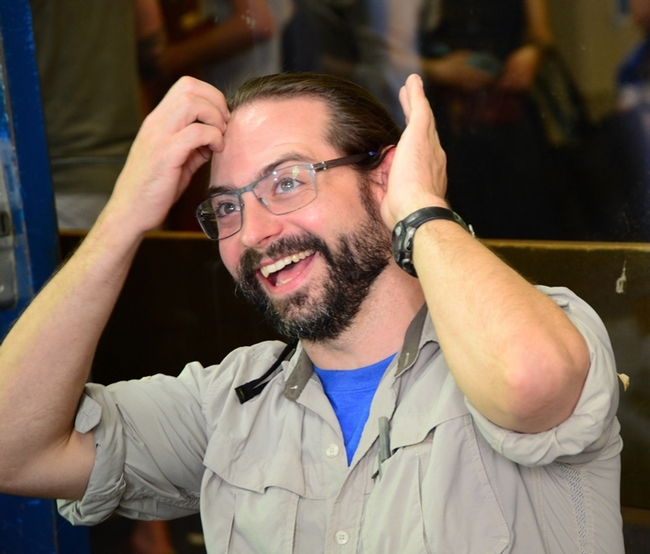
- Author: Kathy Keatley Garvey
I call him the Mountain Boy.
A male carpenter bee, Xylocopa tabaniformis orpifex, appeared in our pollinator garden in Vacaville, Calif.,on Feb. 27, the earliest we've seen this species.
It's the smallest of California's carpenter bees and is often called the foothill or mountain carpenter bee.The females are black with light smoky-colored wings. The male has bright yellow marks on the lower part of its face and some yellow hairs on the top front of its thorax.
In addition to the mountain carpenter bee, California's species are:
- The Valley carpenter bee, Xylocopa varipuncta, the largest of the California carpenter bees. It's about an inch long. The female is solid black, while the male, commonly known as "the teddy bear bee," is a green-eyed blond. Why teddy bear? It's fuzzy and does not sting--or as the late Robbin Thorp (1933-2019) distinguished emeritus professor of entomology at UC Davis, was fond of saying: "Boy bees don't sting."
- The California carpenter bee or Western carpenter bee, Xylocopa californica, the second largest of the California carpenter bees. It's often found in the mountain foothill areas of northern and southern California. It's known for its distinctive distinctive bluish metallic reflections on the body, Thorp says. The females have dark smoky brown wings.
Look around. You may find a "mountain boy" or a "mountain girl" foraging in your yard or local park.
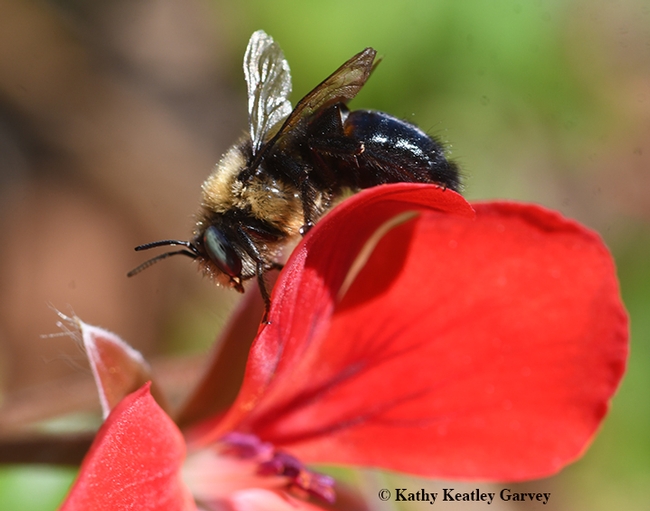
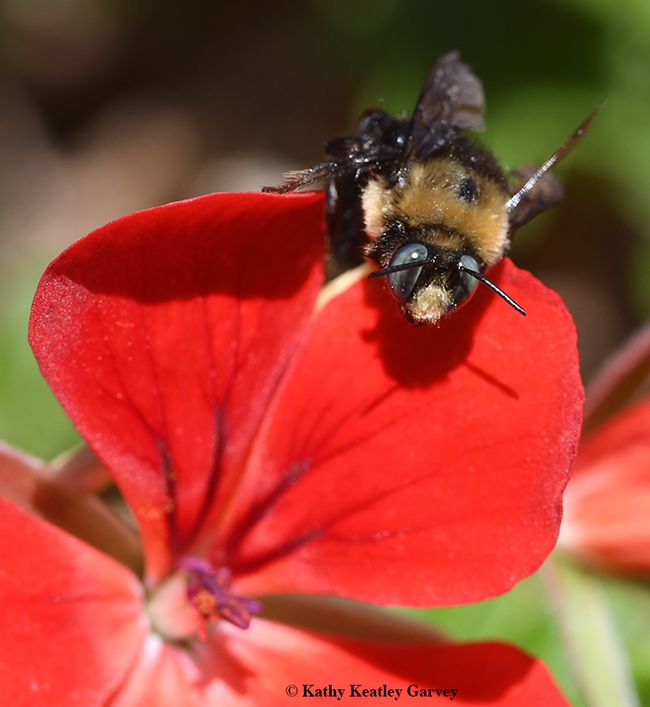
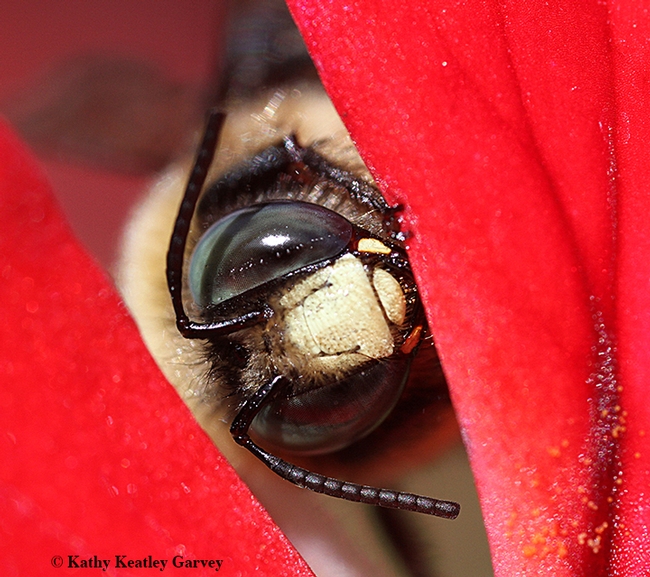
- Author: Kathy Keatley Garvey
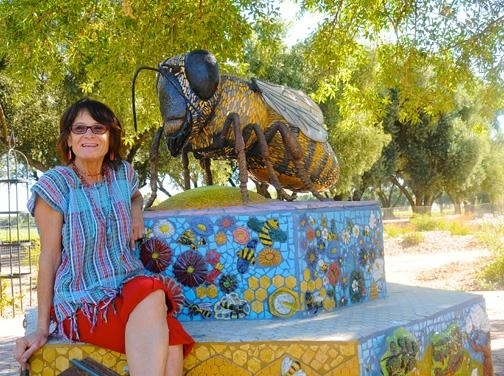
Titled "Miss Bee Haven," it anchors the half-acre bee garden, which was installed in the fall of 2009 and named for its primary donor.
The sculpture is the work of self-described "rock artist" Donna Billick of Davis. She designed, fabricated and constructed Miss Bee Haven, using rebar, chicken wire, sand, cement, tile, bronze, steel, grout, fiberglass and handmade ceramic pieces. The project took her four months to complete.
Miss Bee Haven, appropriately placed beneath an almond tree in June, 2010, is no lightweight. Anchored with 200 pounds of cement and with six bronze legs drilled into the pedestal, this worker bee is destined to stay put—unlike the thousands of bees that forage from the hives at the nearby Harry H. Laidlaw Jr. Honey Bee Research Facility.
Billick used lost wax bronze casting to craft the six legs, which extend from the thorax to rest on a ceramic “purple dome” aster, fabricated by Davis artist Sarah Rizzo. The purple dome aster is among the flowers in the garden.
She created the double set of translucent wings with three sheets of fiberglass. The result: wings that are fragile-looking and true to life, but strong.
During this entire process, I developed a real in-depth relationship with honey bees,” Billick told us back in 2010. For inspiration and detail, she visited the Laidlaw facility apiary, read about the functions of bees, and held the thoughts close. “It was not about expressing anything other than the beeness. I have a lot of respect for bees. It was fun and satisfying to do. I learned a ton.”
Billick toyed with a scientific career before opting for a career that fuses art with science. She received her bachelor of science degree in genetics in 1973 and her master's degree in fine arts in 1977, studying art with such masters as Bob Arneson, Roy De Forest, Wayne Thiebaud and Manuel Neri.
Billick traces her interest in an art career to the mid-1970s when then Gov. Jerry Brown supported the arts and offered the necessary resources to encourage the growth of art. He reorganized the California Arts Council, boosting its funding by 1300 percent.
The mid-1990s is when Billick and Ullman began teaching classes that fused art with science; those classes led to the formation of the UC Davis Art/Science Fusion.
The garden, maintained and operated by the UC Davis Department of Entomology and Nematology, is directed by Extension apiculturist Elina Lastro Niño and managed by Christine Casey. It is open to the public from dawn to dusk. Admission is free.
Meanwhile, "Miss Bee Haven" is likely the most photographed bee in the garden. Visitors pull out their cell phones to take a selfie. Children love to touch it and help the younger ones climb to the ledge. Bee scientists marvel at the anatomical accuracy, right down to pollen baskets and stinger.
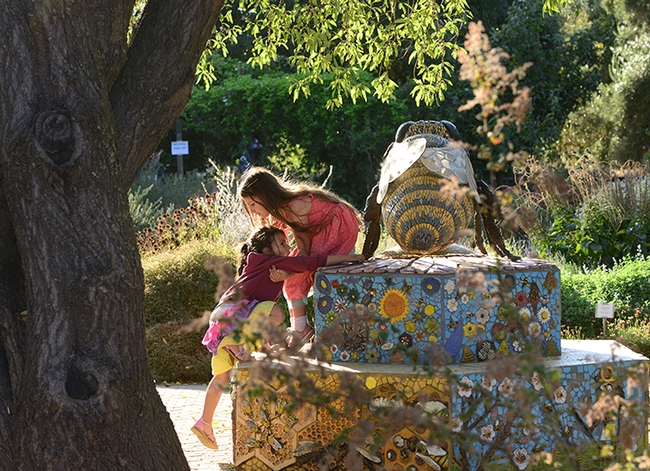
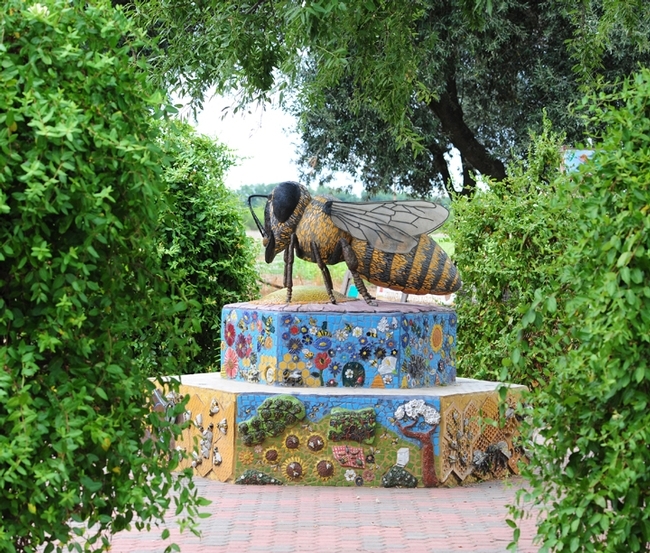
- Author: Kathy Keatley Garvey
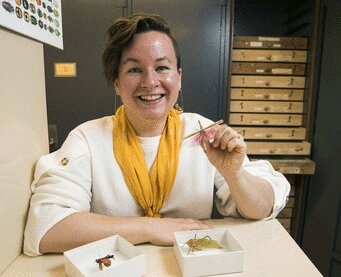
Postdoctoral research fellow and insect biomechanist Mary Salcedo of Virginia Tech has. She studies insect wings.
Salcedo will present a seminar on "Hydraulics in an Insect Wing: How Venation Pattern Affects Circulation" at the UC Davis Department of Entomology and Nematology seminar from 4:10 to 5 p.m., Wednesday, March 11 in 122 Briggs Hall.
"Insect wings are flexible, dynamic living structures that are composed of long tubular veins, and thin membrane," she says in her abstract. "Veins act as conduits, containing hemolymph (insect blood), oxygen supply (through trachea tubes), and nerves (sensory information in flight). Wings allow an insect to perform a myriad of behaviors such as predation, migration and pollination."
"In my research, I work to understand how wing health and function is maintained, and how that relates to insect development, behavior, and ecosystem. My research program incorporates foundational physiology (wing vein structure, venation pattern active systems) quantifying the biomechanics of flow produced by an insect (circulation, wing expansion, flapping flight), and determining how agricultural practices affect insect health. Here I will discuss how venation pattern affects circulation dynamics in the wings of the North American grasshopper (Schistocerca americana) and how it barely scratches the surface of understanding circulation in insects."
In a First Person piece in Biology Open, the Company of Biologists, Salcedo describes herself as "an insect biomechanist, but perhaps functional morphologist is more accurate. I've studied how insects fly, how their muscles move, how they breathe and circulate hemolymph. My PhD looked into their wing structure at several levels: external, internal and global. Externally, I looked at how wing shapes differ between species and how we might compare them. Within the insect wing vein, I studied how hemolymph is transported across the wing. Overall, I looked at how an insect's multiple hearts contribute to internal circulation."
Salcedo, who received the National Science Foundation Postdoctoral Research Fellowship to investigate fundamental insect physiology, holds three degrees: a bachelor of science in applied and computational math sciences (2012( from the University of Washington; a bachelor of science in molecular, cellular and developmental biology (2012) from the University of Washington, and a doctorate in biomechanics, biology and applied math (2018) from Harvard.
Coordinating the seminars is community ecologist Rachel Vannette, assistant professor, UC Davis Department of Entomology and Nematology (rlvannette@ucdavis.edu). To access the program live, go to https://zoom.us/j/559909612 and enter meeting ID: 559 909 612.
One tap mobile:
+14086380968,,559909612# US (San Jose)
+16699006833,,559909612# US (San Jose)
Dial by your location:
+1 408 638 0968 US (San Jose)
+1 669 900 6833 US (San Jose)
+1 646 876 9923 US (New York)
Meeting ID: 559 909 612
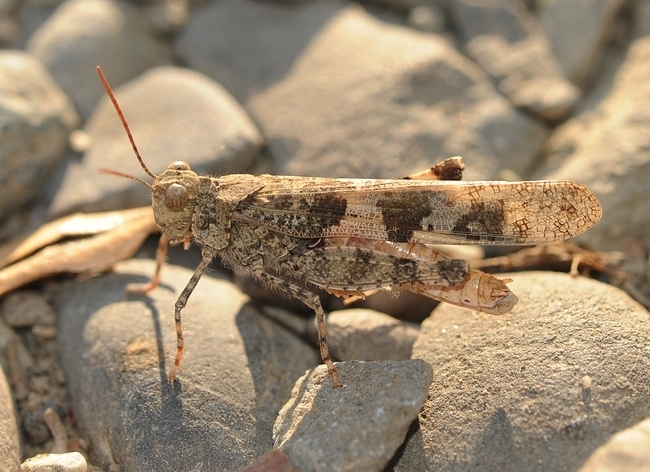
- Author: Kathy Keatley Garvey
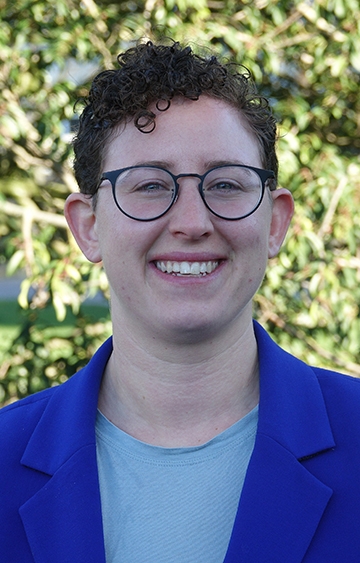
Bick, an agricultural entomologist who received her doctorate in entomology in June 2019 from UC Davis and then headed for the University of Copenhagen for her postdoctoral fellowship, has just received a $23,000 fellowship from the American Scandinavian Foundation for her proposal, "Designing Pest-Resilient Apple Orchards Using Bespoke Models."
This stipend will help support one year of living expenses while she pursues ecological modeling at University of Copenhagen.
She will be leveraging Professor Lene Sigsgaard's apple orchard data and aiming to add spatial capability to Professor Neils Holst's Universal Simulator. Both professors are supervising the grant.
The abstract of the proposal:
“This proposal aspires to address civilization's greatest challenge: sustainably feeding our global population. Approaching agricultural food production as an ecosystem rather than an industrial process allows for greater sustainability. This systems approach allows farmers to sustainably intensify their agroecosystem using the tool with the greatest impact: redesign. Models can be used to pre-screen designs for optimal pest management. I propose using modelling to design pest-resilient apple orchards. Specifically, the proposal focuses on the combination of pest-attractant crops (Trap Crops), increasing plant diversity (Dilution Effects) for masking crops from pests, and using diverse crops to support natural enemies (Natural Enemy Effects). The combination of modelling and orchard design could result sustainably intensifying apple production in Europe.”
She earlier received a $244,000 postdoc grant from the Innovations Fund in Denmark. (See Bug Squad)
Emily's entomological journey began at Cornell University, where she received her bachelor's degree in entomology in 2013. She then received two degrees in entomology from UC Davis: her master's degree in 2017 and her doctorate in 2019.
Bick, who specializes in integrated pest management, helped anchor the UC Davis Department of Entomology and Nematology Linnaean Games Team that won the national championship at the ESA meeting in 2016, and the University of California (UC Davis and UC Berkeley) Linnaean Games Team that won the national championship in 2018. The Linnaean Games, launched in 1983, are lively question-and-answer, college bowl-style competitions on entomological facts and played by winners of the ESA branch competitions. The teams score points by correctly answering random questions. (Watch the championship game on YouTube). She also served as vice president of the UC Davis Entomology Graduate Student Association (EGSA).
Bick served as an emergency medical technician from 2008 to 2017 and gained her pesticide applicator's license in 2013. She was singled out to receive the Student Certification Award at the Entomological Society of America (ESA) meeting in 2018. In 2014, she was named a Board-Certified Entomologist, a honor bestowed on her at the ESA meeting.
